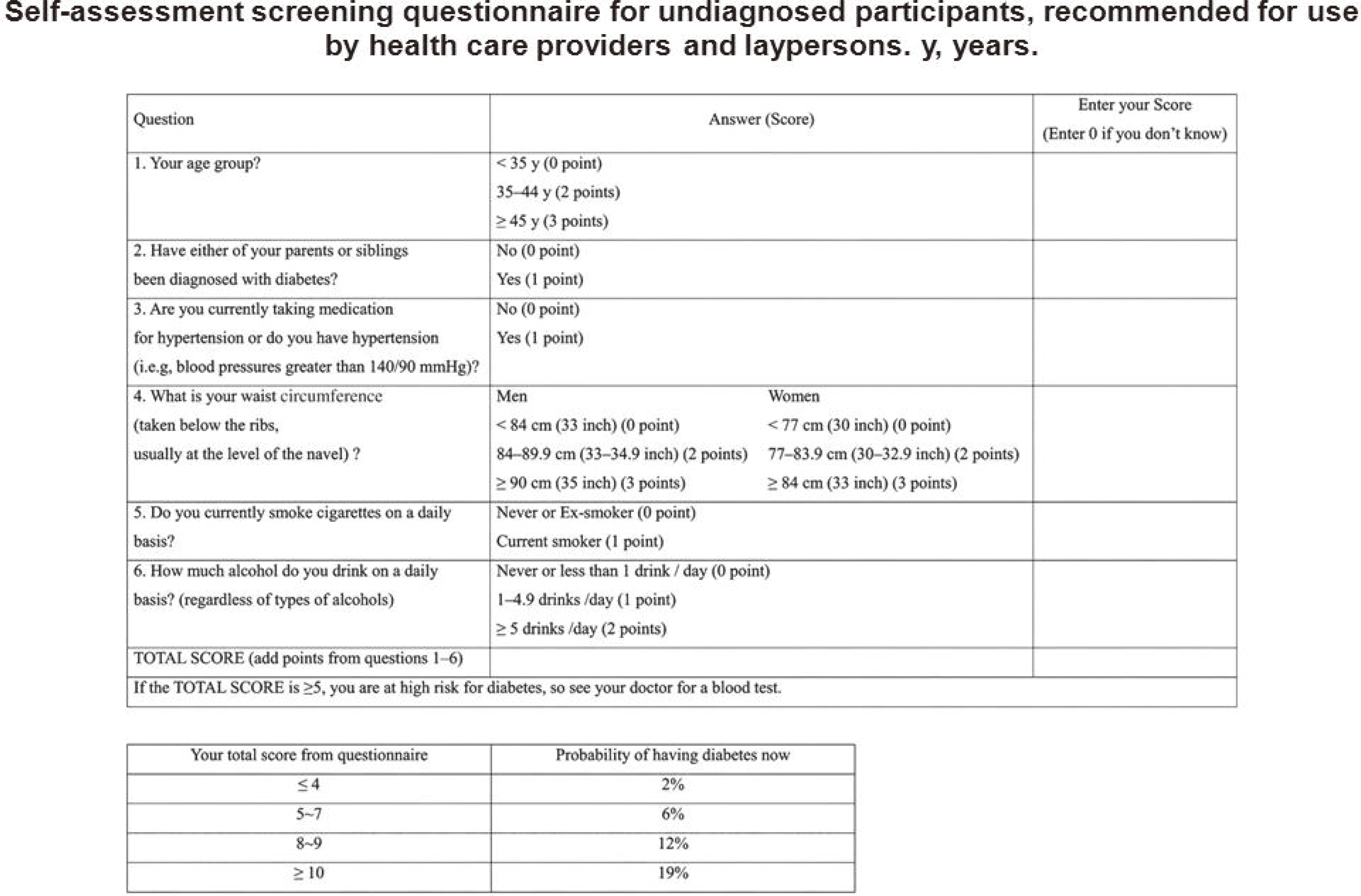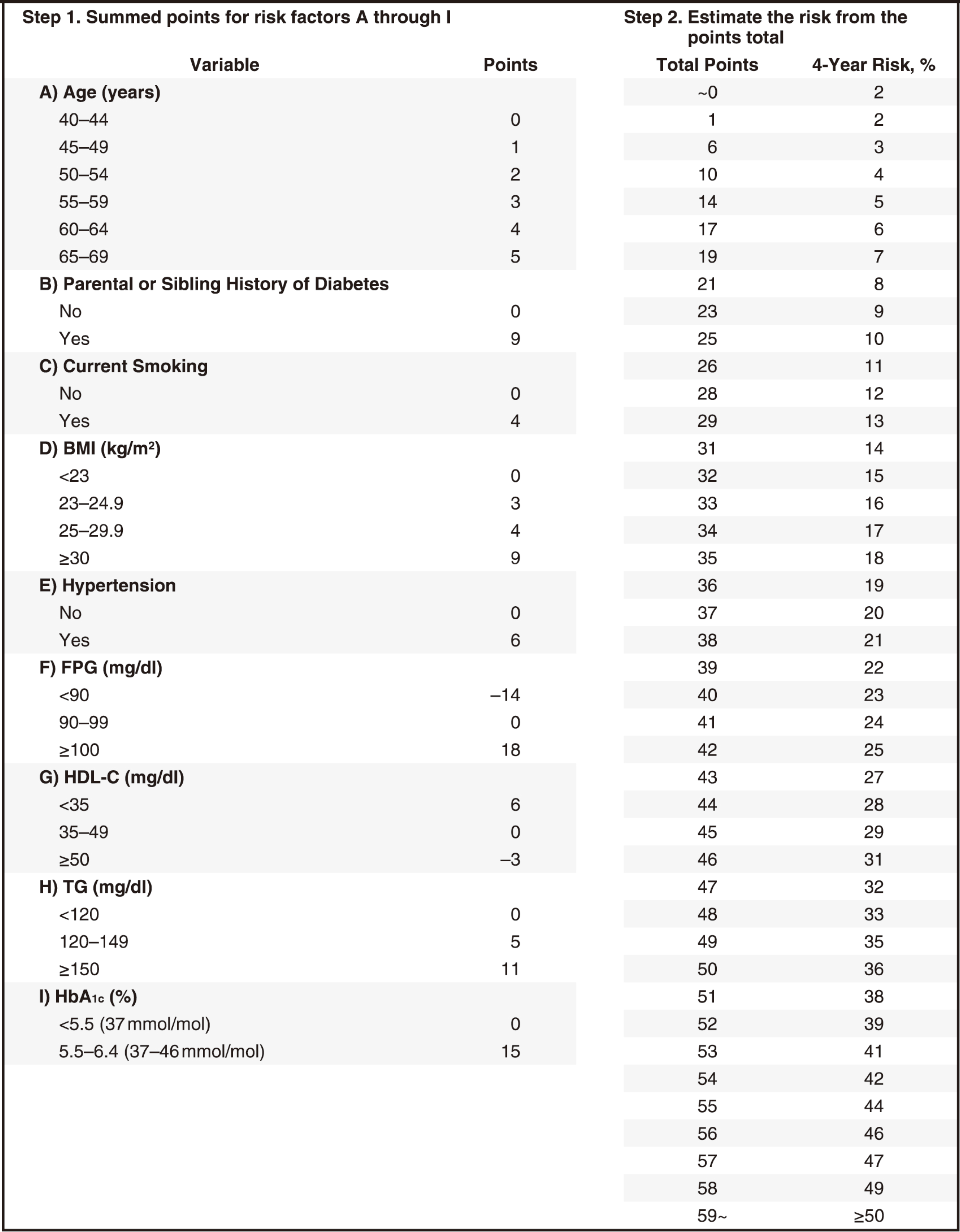Abstract
Type 2 diabetes mellitus is one of the most common chronic metabolic disorders in the world, and its prevalence is rapidly increasing. According to an analysis of the 2010 Korea National Health and Nutrition Examination Survey (KNHANES), the overall prevalence of diabetes in Korea increased to 10.1% (3.2 million people) in 2010. Among middle-aged Korean adults, one out of two respondents was first diagnosed with diabetes by the survey, indicating that a significant number of individuals may potentially be at risk for undiagnosed diabetes. Therefore, early screening and detection of diabetes is essential to avoid diabetes-related morbidity, reduce health care costs, and prevent the deterioration of quality of life. Many risk-score questionnaires and algorithms for use in various countries and ethnic groups to identify people at high risk for diabetes have been proposed. We developed and validated a self-assessment score for diabetes risk in Korean adults. Although further prospective studies are needed to evaluate the utility and feasibility of this score in various settings, this self-assessment score may be useful for identifying Korean adults at high risk for diabetes.
REFERENCES
2. SChoi YJ, Kim HC, Kim HM, Park SW, Kim J, Kim DJ. Prevalence and management of diabetes in Korean adults: Korea National Health and Nutrition Examination Surveys 1998-2005. Diabetes Care. 2009; 32:2016–20.
3. SBang H, Edwards AM, Bomback AS, Ballantyne CM, Brillon D, Callahan MA, Teutsch SM, Mushlin AI, Kern LM. Development and validation of a patient self-assessment score for diabetes risk. Ann Intern Med. 2009; 151:775–83.

4. SRamachandran A, Snehalatha C, Vijay V, Wareham NJ, Colagiuri S. Derivation and validation of diabetes risk score for urban Asian Indians. Diabetes Res Clin Pract. 2005; 70:63–70.
5. SLindstrom J, Tuomilehto J. The diabetes risk score: a practical tool to predict type 2 diabetes risk. Diabetes Care. 2003; 26:725–31.
6. SHippisley-Cox J, Coupland C, Robson J, Sheikh A, Brindle P. Predicting risk of type 2 diabetes in England and Wales: prospective derivation and validation of QDScore. BMJ. 2009; 338:b880.

7. SAekplakorn W, Bunnag P, Woodward M, Sritara P, Cheepudomwit S, Yamwong S, Yipintsoi T, Rajatanavin R. A risk score for predicting incident diabetes in the Thai population. Diabetes Care. 2006; 29:1872–7.
8. SGao WG, Dong YH, Pang ZC, Nan HR, Wang SJ, Ren J, Zhang L, Tuomilehto J, Qiao Q. A simple Chinese risk score for undiagnosed diabetes. Diabet Med. 2010; 27:274–81.
9. SRathmann W, Martin S, Haastert B, Icks A, Holle R, Löwel H, Giani G. KORA Study Group. Performance of screening questionnaires and risk scores for undiagnosed diabetes: the KORA Survey 2000. Arch Intern Med. 2005; 165:436–41.
10. SGlümer C, Vistisen D, Borch-Johnsen K, Colagiuri S. DETECT-2 Collaboration. Risk scores for type 2 diabetes can be applied in some populations but not all. Diabetes Care. 2006; 29:410–4.
11. SLee YH, Bang H, Kim HC, Kim HM, Park SW, Kim DJ. A simple screening score for diabetes for the Korean population: development, validation, and comparison with other scores. Diabetes Care. 2012; 35:1723–30.
12. SMinistry of Health and Welfare. Korea National Health and Nutrition Examination Survey (KNHANES) 2008. Seoul: Ministry of Health and Welfare;2009.
13. SHeikes KE, Eddy DM, Arondekar B, Schlessinger L. Diabetes Risk Calculator: a simple tool for detecting undiagnosed diabetes and pre-diabetes. Diabetes Care. 2008; 31:1040–5.
14. SBaan CA, Ruige JB, Stolk RP, Witteman JC, Dekker JM, Heine RJ, Feskens EJ. Performance of a predictive model to identify undiagnosed diabetes in a health care setting. Diabetes Care. 1999; 22:213–9.
15. SLim NK, Park SH, Choi SJ, Lee KS, Park HY. A risk score for predicting the incidence of type 2 diabetes in a middle-aged Korean cohort: the Korean genome and epidemiology study. Circ J. 2012; 76:1904–10.
Fig. 1.
Self-assessment screening questionnaire for undiagnosed participants, recommended for use by health care providers and laypersons. Adapted from Lee YH et al. Diabetes Care 2012;35:1723-30[11].

Fig. 2.
Calculation of risk scores to predict a 4-year risk for type 2 diabetes (from KoGES). Adapted from Lim NK, et al. Circ J 2012;76:1904-10[15].

Table 1.
Logistic regression analyses for related factors for undiagnosed diabetes




 PDF
PDF ePub
ePub Citation
Citation Print
Print


 XML Download
XML Download